Organizing My Life With Things 3 in 2025
An updated look at my streamlined Things 3 productivity system after four years of refinement. Discover how I've evolved my task management approach with a focus on Life Admin+, structured Internal Fridays for business development, and maintaining a trusted system that actually works in practice.
Almost four years ago exactly, I wrote about how I use Things 3 to organize my life (and work). It’s one of my most popular articles to this date.
For those unfamiliar, Things 3 is a task management app for Mac, iPhone, and iPad that follows the Getting Things Done methodology. It's known for its clean design and flexible organizational structure using areas, projects, and tags.
As you can tell from the title of this post, I’m still using Things 3 (and I’m not holding my breath for Things 4 to be released anytime soon). How I use it is still very similar, but also a bit more streamlined. This is in part because I have a three-tool productivity system; Things is just one third of that system. (My calendar and notes app are the other two, in case you’re wondering.) That said, I feel that the changes are substantial enough to warrant an updated article.
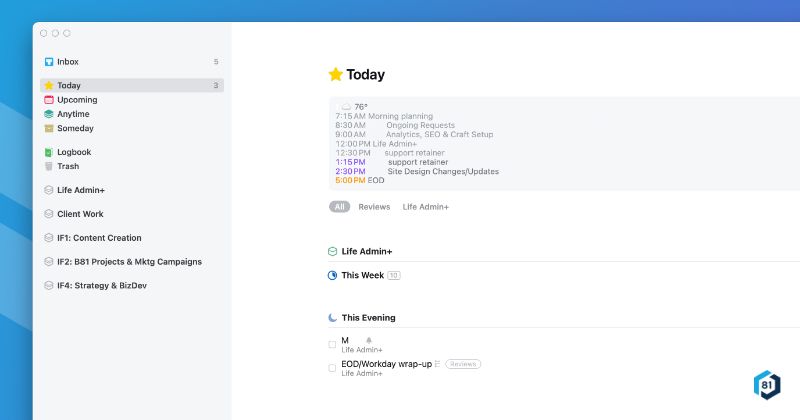
Setup overview
I’m often tweaking and adjusting my productivity system—probably too often. As such, I’ve gone through various iterations of my setup since 2021. Interestingly enough though, it’s still pretty similar to that version, at least on the surface.
That said, my Areas and how I manage projects feel like they’ve changed significantly. With that in mind, let’s dive into the core elements of how I use Things 3 these days.
Inbox
As far as Things 3 and capturing tasks digitally go, the Inbox is the crux of it all. While I also use my Bullet Journal to jot down thoughts and ideas that come up throughout my work day, Things’ quick capture is essential for tasks or ideas that need to reference a link or a file on my Mac. As much as I love analog, capturing digitally is vital to my work as a designer and developer.
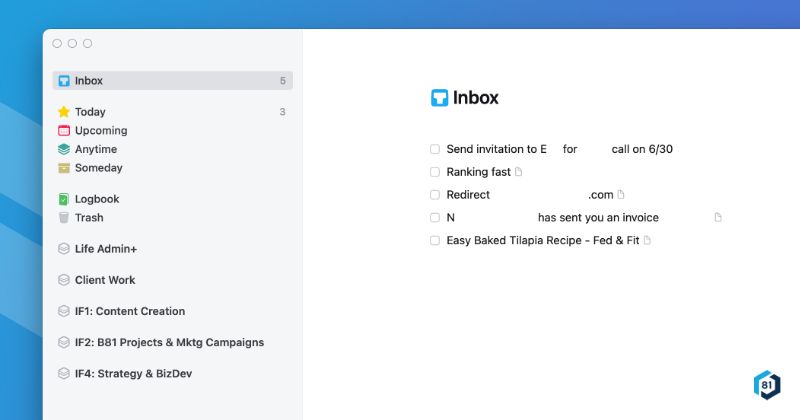
The Inbox gets processed every day during my workday wrap-up. A lot of folks call this a daily review, but I prefer the term wrap-up because it provides a very clear transition from work to non-work time. That delineation becomes clearer with the tasks involved in this wrap-up, which are all about processing open loops and putting things where they need to be.
Areas
I have five core areas, though the last three are basically one area that I’ve split into three.
Life Admin+
This first area is a bit difficult to describe accurately and simply, but the gist is that any tasks that really don’t fit into a project or another area go here, both one-off and repeating tasks. They’re not just work related—they’re also for non-work things I need to do, such as reminders to do the mundane like putting the trash bin out, paying bills, calls I need to make, etc. I named it Life Admin+ because the tasks it contains don’t fit just in work or personal or a short list of buckets or categories. It used to be called "Admin" but that felt far too formal and work focused. I added "Life" because it encompasses all areas of my life. And the "+" is to add that as an emphasis.
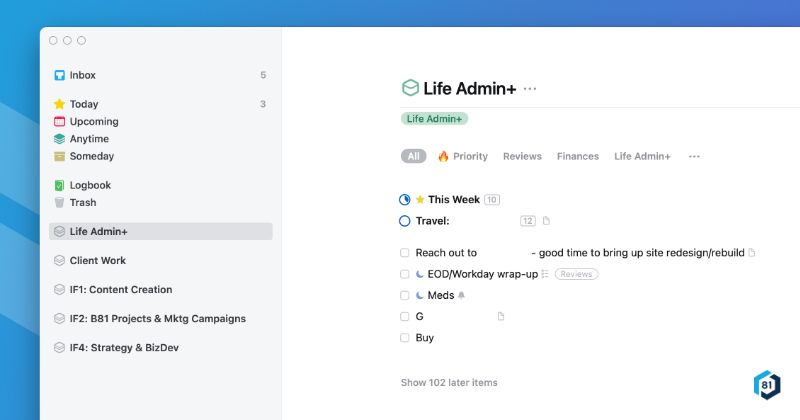
I use the Someday context/feature for a lot of tasks in here when I’m not sure if I want to do the task or when, if ever. These are supposed to get reviewed every week, but honestly it’s closer to monthly.
I have one constant project in Life Admin+ that I’ve only recently started experimenting with: This Week.
I started noticing that I was adding a lot of tasks to different days of the week without a clear way to see how many I had on any given day. Not too long ago I had a good twenty or so tasks on a single day. Part of that is due to the inability to see the number of LA+ tasks per day easily (yes, the Upcoming view could work but for some reason I don’t like it). Constantly pushing tasks out would create a large backlog as well. So I decided to try something different.
I do a weekly review every Sunday which includes planning out my work week. With the new This Week project, I review tasks under LA+ and move them to This Week. I keep the number of tasks between 10-30 with fifteen or twenty being the sweet spot. It’s still early days and it’s a tiny experiment but so far it’s been a good solution. As you can probably tell, experimenting is a big theme in my productivity workflow. It’s necessary to figure out what works and to change when something no longer serves you. As we change and life changes, it’s to be expected that our productivity workflows would change too.
My partner and I still travel quite a bit, doing extended stays in different locations when we can, but I don’t have a dedicated Area for this anymore. Instead, when we start talking about our next destination (be it home or elsewhere) and are in the planning stages, I’ll create a new project for that particular trip.
Client Work
I used to separate this into two areas (support and projects), but I merged them due to how I manage support tasks. For all of my website support retainer clients, I use ActiveCollab (a project management and collaboration platform) for request management and discussion. To avoid doing double-entry and to keep things simple, each support "project" in Things contains a link to the related support retainer in ActiveCollab. When I have time blocked off to work on a particular retainer, I find it in Things 3, click the link to ActiveCollab, and see what’s next to work on.
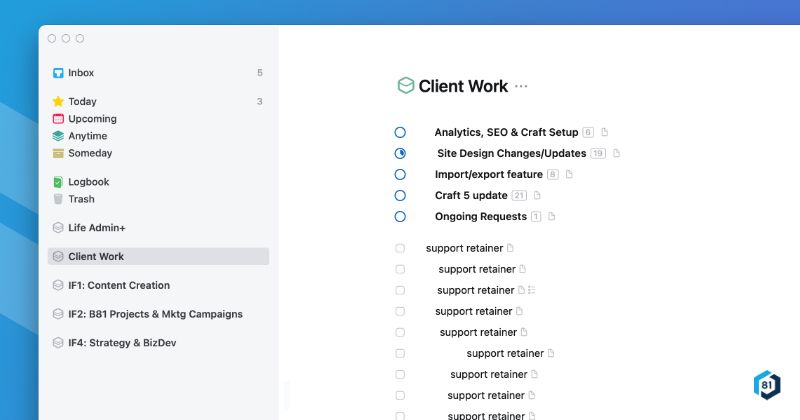
Non-support projects get the actual Project context/item in Things 3. I do the bulk of my project management work in each project. Each project gets relevant tasks, organized by headings for project phases.
I use Someday within the Client Work area for projects that are on hold or are coming up later.
IF1, IF2, IF4
These three areas represent my biggest organizational change: dedicating Fridays to working on my business rather than in it. I've structured these Internal Fridays ("IF") into four rotating themes, with each Friday focused on a specific aspect of business development.
This change has been crucial. Previous to this setup, business tasks and projects, such as blog writing, Block 81's YouTube channel video production, newsletter writing, checking analytics, etc. were being squeezed in wherever I could fit them on my calendar. Unfortunately this resulted in things getting delayed, pushed out, or simply not having enough time to focus on any one thing.
I started by simply blocking off Fridays in general, which worked, but things were still slipping between the proverbial cracks. I finally sat down one day to list all the things that I needed to do, from content creation to client check-ins to business metrics. I realized there was a lot and I was trying to do far too much.
I don’t want to get too into the weeds about this, especially since it’s pretty personal to how I work and run my business, but I ended up grouping these business tasks and projects into three Fridays, leaving the fourth Friday as a buffer for client work, personal time, or additional business things I want to get done..
IF1: Content Creation. This is quite literally just creating content for this blog, my YouTube channel, social media posts, and my newsletter. I’ve allocated blocks of time for each, but I also try to be flexible because there are times when I might do one faster than the other or I might have enough scheduled in advance I can focus more on another. For example, I find writing for my blog much easier than producing a YouTube video (purely due to time), so I tend to be a bit more prolific with that. If I have written enough and have schedule two or three posts well in advance then I can dedicate a bit more time to video production.
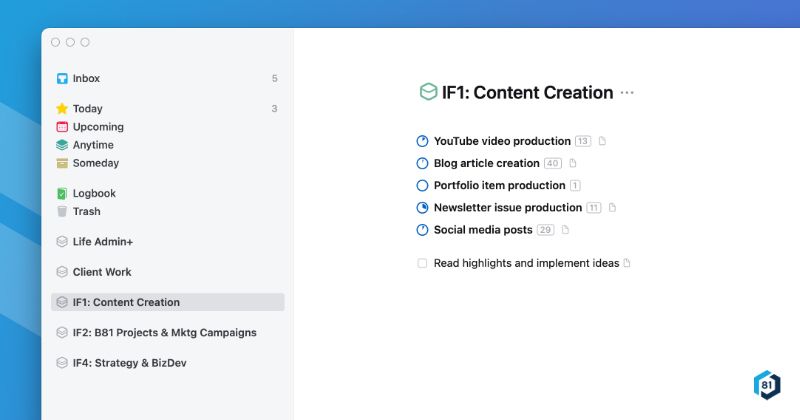
IF2: B81 Projects & Marketing Campaigns. As a solo entrepreneur, especially within the last couple of years, I’ve tried to find ways to increase revenue without increasing my workload. Those end up being side projects, to which I dedicate approximately half a Friday. The rest of the time I divide between website updates and fixes and marketing my business and the services I offer.
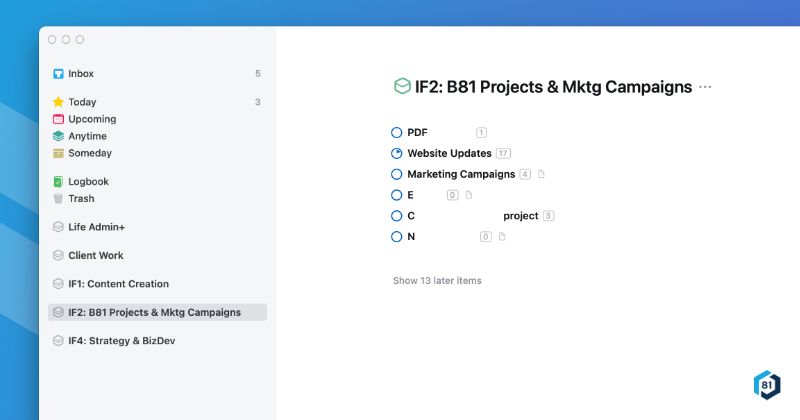
IF3: Buffer Day. Both IF1 and IF2 involve creating. Sometimes the creative process, for whatever project it may be, can be longer than one anticipates and you fall behind or have to put in extra time in the evenings or weekends. This is something that I constantly ran into before implementing this system. That’s not to say I don’t run into that now—I absolutely do. Some blog posts take longer to write, some videos take longer to edit, and sometimes I just end up super distracted. The difference now is that I’ve built in a "make up" day into the system so that I don’t stress myself out and find myself working more than I really should or worse, falling super behind on any of these things. Obviously I can’t fit everything into my buffer day, so I prioritize as best I can based on when I want to publish something and whether a certain area has content that will be automatically published later.
IF4: Strategy & Business Development. This is less creative-intensive and instead focuses client nurturing, ensuring my ideas "pipelines" for my various channels are still full (and cutting what no longer makes sense), reviewing business metrics/analytics, and professional development. It’s pretty straightforward and ensures that I’m not just throwing stuff on the wall to see what sticks—I’m creating things with a purpose.
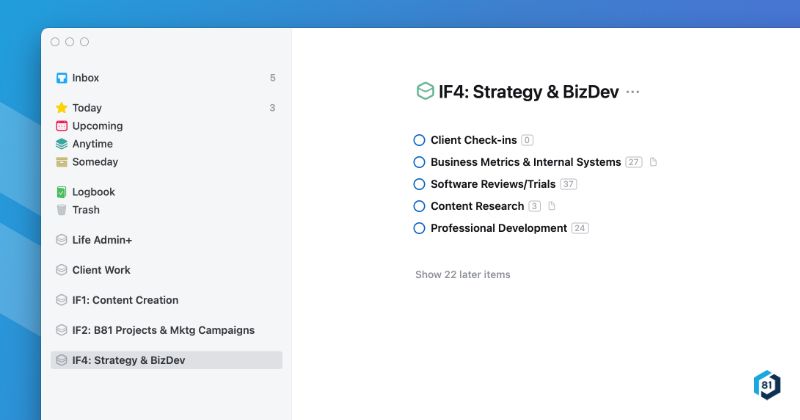
Tags
I was using more tags four years ago than I am now. In fact, this is one area in Things 3 where I feel like I experimented the most. What I realized is that while tags are useful, I find it cumbersome to remember to tag items, especially if there are a lot of tags. So I’ve whittled my tags down to four:
- Priority - for those truly important things that should be addressed before anything else.
- Reviews - to separate out the three "review" tasks I do at the start of the day, middle of the day, and end of day.
- Life Admin+ - to tag certain tasks within projects that are quick and should be done during my Life Admin+ time block, such as following up with a client.
Upcoming, Anytime, and Someday
The first two of these three time contexts rarely get used by me. As I mentioned earlier, I just don’t really like the Upcoming view. I’m not entirely sure why. I think I’d use it more if I could filter it by date or date range rather than having it be one long vertical list of tasks grouped by date.
Anytime is similar. The idea behind it is that if/when you miraculously get through all your tasks for the day and you have extra time and energy, you’d look through Anytime and choose something there to work on. In my many years of Things, I don't think I've ever done that. Instead, I’m more likely to pick an internal project or a content creation project I’m extra excited about to work on. Of course that’s if I have extra time—I often don’t.
Then there’s Someday. I do use this, as I’ve mentioned previously. I use it mainly as a way to hide my long lists of ideas or projects/tasks on hold. I try to review these regularly but usually don’t because there’s always something that’s active or in progress. The exception to that is Client Work—I make sure to review client projects I have on hold to make sure I check-in regularly, follow-up, schedule the project, etc.
Dates
Like some other task management apps, Things 3 gives you the ability to add a start date and/or a deadline to your tasks and projects. I really want to say that I don’t use either much but that’d be a lie. I really try not to use them, but there are instances where it’s important to add either or both. There are just some tasks that can’t be started until a specific date or tasks that must meet a deadline. So I try to be practical and choosy about these.
I only add a start date if it really makes sense. For example, I might need to see my doctor a year from now but they won’t schedule an appointment that far in advance. So I’ll add it to Life Admin+ and set a start date of maybe a month or two before I need to see them.
Similarly, tasks don’t get deadlines unless there’s a very real consequence of not completing that task by that deadline. Examples of this include canceling a subscription, submitting a proposal, avoiding a late fee, etc.
Part Of a Trusted System
While I will fully admit I nerd out on productivity, the fact is the only way to know what works for you and what doesn’t is by trying things. As a productivity nerd I can very easily fall into the trap of spending too much time on stuff like this. I also am susceptible to Shiny Object Syndrome—I can’t tell you the number of times I’ve looked for another app to replace Things 3 and end up sticking with Things because it works how I need it to.
That all said, I’ve managed to stay pretty productive despite all the experimenting and changing my setup several times since I wrote the previous article. I’m convinced that’s because I’ve learned to trust my systems.
A trusted system is still, and always will be, paramount to any productivity or project management workflow. How I use Things in my productivity system is just one component with its own own workflow that keeps me on top of things. Pun totally intended. 😎